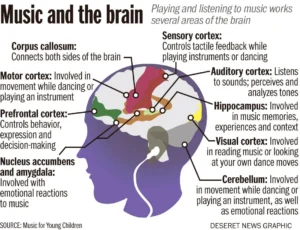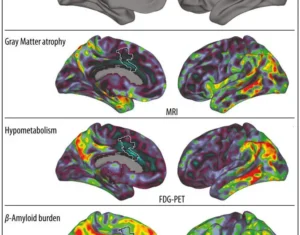
Our favorite music can immediately uplift our moods, there is actual science behind that. The euphoric sensations we feel when we hear a moving piece of music is the result of dopamine release–a neurotransmitter that triggers sensations of pleasure and well-being.
In fact, our bodies release dopamine as soon as we hear the first few notes of a song we already love. Research found that both casual and focused listeners had slightly higher average scores for mental well-being and lowered levels of anxiety and depression compared to others who didn’t listen to music as frequently.
The Boundless Benefits Of Music Listening
Whether we listen casually or intently, or soaking in the experience of a live musical event, there are boundless benefits that come from listening to music.
An American survey by AARP and numerous studies reveal the boundless neuroscientific and psychological benefits experienced by people who frequently listen to music. Their results help understand why music is good for our mental and emotional wellbeing.
Neuroscientific effects of music on the brain activates almost all regions and networks which are responsible for well-being, learning, cognitive function, quality of life, and happiness. In fact, there is one other situation in which you can activate so many brain networks all at once, and that is when we participate in social activities.
Music in particular lights up the hippocampus and amygdala which activate emotional responses through memory. As well as, the limbic system which generates pleasure, motivation, reward and the body’s motor system. Therefore, music keeps our cognitive abilities sharp and our memories well-remembered.
A survey was conducted and their respondents who go to musical performances, 69% rated their brain health as “excellent” or “very good,” compared to 58% for those who went in the past and 52% for those who never attended.
Additionally, participants who reported often being exposed to music as a child, 68% rated their ability to learn new things as “excellent” or “very good,” compared to 50% of those who were not exposed to music.
Furthermore, active musical engagement, especially for those over age 50, was associated with higher rates of happiness and good cognitive function. As mentioned above, music has been shown to activate some of the broadest and most diverse networks of the brain.

Music Collectively Lights Up The Brain
The parts of the brain involved in emotion are not just collectively activated during emotional music, they are also synchronised like a cognitive crescendo.
In fact, music activates the auditorium cortex in the temporal lobes close to our ears as well as the motor system. Interestingly enough, it is this activation of the brain’s motor system that allows us to choose the genre of music we’re likely to tap our foot to.
Subsequently, Langheim et al. (2002) discovered additional activations in various brain areas during anticipated music. In another exploration, Nirkko et al. (2001) demonstrated that playing a musical sequence on a violin led to activation in several brain regions.
Notably, the latter study highlighted the involvement of bilateral fronto-opercular regions which actively present in both music and language production. Ultimately, our brain’s reaction to music, whether in perception or production, is a symphony of neural activations across multiple brain regions.

The Transformative Effect Of Music On Brain Disorders
The potential of music-based interventions in the neurological realm is significantly large, especially in mending motor or cognitive functions. A growing evidence suggests that listening to for example Mozart’s Sonata for Two Pianos in D Major reduces the frequency of seizures in some people with epilepsy. In addition to other conditions and diseases such as Parkinson’s, depression and Alzheimer’s.
Music has been linked with improving memory and hence has been therapeutically harnessed to help patients with Alzheimer’s and dementia.
Through the use of musical therapy, familiar tunes have been found to revive and re-awaken past memories and experiences in elders diagnosed with Alzheimer’s and dementia. Not to mention, it was found to enhance mood and bolster social interactions. Alternatively, music therapy has been successfully assisting other patients who experienced severe strokes to regain verbal memory.
Scientists and researchers are attempting to identify the exact type of music which provokes particular cognitive, motor, or emotional response. In accordance, they can pave progress towards healing and improving disrupted brain function in various diseases.
One of the ways they’re able to achieve those findings is through neuroimaging. The process of neuroimaging provides structural and functional abnormalities of the brain based on music processing during studious trials.
In one of the neuroimaged case studies, it was shown that silbersweig which is seen in people who survive strokes or tumors develop sensory amusia– a lesion in the brain that recognizes various sounds collectively. Patients with sensory amusia lose the ability to perceive or respond to sound.
Therefore, patients with this condition may not be able to revive damaged tissue, but exposure to music itself indirectly makes up for the setback. With consistent exposure to various types of music, a person’s neurons will fire in new ways.
The particular tunes that have the most positive effects on cognitive function in brain tumors and stroke patients are yet to be identified in certitude. On the other hand, familiar musical tunes in patients with Alzheimer’s and dementia have been shown to have the most positive effects on reviving memory and alertness.

The region for musical memory (top: red, otherwise surrounded by a white border) compared with other regions of the brain of an Alzheimer’s patient: areas with maximum neuronal loss (2nd row from above), decrease in metabolism (3rd row from above.) Credit: MPI f. Human Cognitive and Brain Sciences.
Music And Mental Health
In a study published August 9 in the Cell Press journal Cell Reports, scientists in China use brainwave measurements and neuroimaging techniques to show how Western classical music elicits positive effects on the brain.
Their goal is to find more effective ways to musically activate the brain in those who don’t respond to depression treatments. The research integrates the fields of neuroscience, psychiatry, and neurosurgery.
The study focused on 13 patients with treatment-resistant depression who already had electrodes implanted in their brains for the purpose of deep-brain stimulation.
These implants are placed in a circuit connecting two areas in the forebrain—the bed nucleus of the stria terminalis (BNST) and the nucleus accumbens (NAc).
Using these implants, the researchers found that music generates the electrodes’ similar to antidepressant effects by synchronizing the neural oscillations between the auditory cortex. The auditory cortex is responsible for processing sensory information, and the rewards circuit is responsible for processing emotional information.
All in all, the relationship between music-listening and mental health is positively abundant. Since firstly, music-listening stimulates the limbic system which helps process emotions and memories.
As well as it produces dopamine which is a neurotransmitter that influences the brain’s reward centers and improves symptoms of depression. Last but not least, music-listening reduces levels of cortisol which is the hormone the body releases when it’s stressed.

Kanye West, seen performing at the Forum in Inglewood in 2017. ( Credit : Marcus Yam / Los Angeles Times)
The Scientific Pleasure Of Listening To Music
As mentioned above, when our brains become familiar with a particular song, our bodies release dopamine as soon as we hear the first few notes of the song.
Intense pleasure in response to music leads to dopamine release specifically in the striatal system. Remarkably enough, the anticipation of an abstract reward results in dopamine composition throughout the anatomical pathway which is different from the peak pleasure driven from it later on. In alignment, humans regularly seek cognitively complex and pleasurable experiences such as music listening, singing, or playing which don’t have any specific survival advantage.
Thus, among the non-survival enjoyable experiences, the pleasure driven from music-listening differs from those fueled by primary rewards since it falls under a pleasure-seeking abstract reward. Not to mention, it’s based on different psychological and neurobiological bases.
As previously mentioned, pleasure driven by music in addition to other things fuel feelings like anticipation and euphoria. Remarkably, previous studies have shown that dopamine-stimulating drugs such as cocaine or amphetamine fuel similar positive affective states in humans.
Furthermore, direct electrical brain stimulation of the NAcc has been shown to elicit smiles and euphoria. Likewise, microinjections of psychostimulants into the NAcc elicit 50-kHz ultrasonic vocalizations in rats which are proposed to reflect a positive affective state.
This micro experiment concludes that the subjective experience of musical pleasure, similar to emotions, arises from motivational signals and cognitive perceptions rather than through primary rewards.
In other words, the present findings show a direct, causal role of dopamine-induced musical pleasure and shed light on the role of the human dopaminergic system in abstract rewards.

Neuroscience Of Learning A Musical Instrument
Neuroplasticity (brain plasticity) is the biological, chemical, and physical capacity for the brain to reorganize its structure and function. Mental activities that lead to brain alterations have significant implications for healthy development, learning, memory, and recovery from brain damage.
These neuroplastic changes range from individual neuron pathways making new connections, to systematic adjustments like cortical remapping.
What Neuroplasticity has miraculously disclosed is that not only developing brains but also all adult brains are susceptible to positive change (neural rewiring). From the neurotypical brain, to the neurodivergent brain and to the brain that has been subjected to psychological or physical traumas. In other words, our brains are ever-evolving as they continually develop when we learn new skills and gain new experiences.
However, the plasticity of our brains don’t remain the same throughout our whole lives. Since our brains can develop and absorb new knowledge quickly when we’re children, they become less ‘elastic’ with age, unless we continually exercise our brains.
Music-learning is the holy grail of Neuroplasticity since when we learn a new song on the guitar for example, the neurons change in our brain by developing new brain cells and connections between them. Most importantly, learning music is limitless which ensures the longevity of brain health. In fact, with music there are endless skills and techniques to master.
Many professional musicians and singers continue to attend lessons for their whole lives to improve and fine-tune their music practice. Wherefore, music-learning makes good use of the malleability of our brains with its lifelong layers of learning.

By : Hania Elweleily







